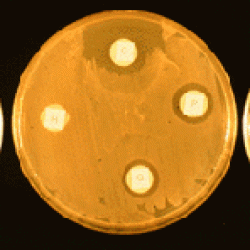Source Institutions
Source Institutions
Add to list Go to activity
Activity link broken? See if it's at the internet archive

In this lab, learners evaluate the relative effectiveness of various chemical substances (i.e. garlic powder, bathroom cleaner, mouthwash, etc.) as antimicrobial agents. Learners use the agar diffusion method to determine "zones of inhibition." This lesson guide includes background information, questions for learners, and additional activity ideas.
- Under 5 minutes
- 4 to 24 hours
- $5 - $10 per student
- Ages 11 - 18
- Activity, Experiment/Lab Activity, Lesson/Lesson Plan
- English
Quick Guide
Materials List (per student)
- Petri plates containing nutrient agar (2)
- Sterile cotton swab
- Forceps
- Ruler
- Disks (use a hole punch on filter paper)
- Test substances: Garlic powder, chemical agents such as bathroom cleaner, floor cleaner, mouthwash, lens cleaner, acne cleaner. Bring your own.
- Staphylococcus epidermis (Gram-positive)
- Escherichia coli (Gram-negative)
Subjects
-
Life Sciences
- Cells
-
Diversity of Life
- Viruses and Bacteria
-
Human Body
- Health and Nutrition
-
Physical Sciences
- Chemistry
-
Mathematics
-
Data Analysis and Probability
- Data Analysis
- Data Collection
-
Data Analysis and Probability
-
The Nature of Science
-
The Scientific Process
- Conducting Investigations
- Gathering Data
- Formulating Explanations
- Communicating Results
-
The Scientific Process
Audience
To use this activity, learners need to:
- see
- see color
- read
- touch
Learning styles supported:
- Uses STEM to solve real-world problems
- Involves hands-on or lab activities
Other
This resource is part of:
Access Rights:
- Free access
By:
- Slowiczek, Ed.D., Fran ; Peters, Ph.D., Pamela M.
Rights:
- All rights reserved, Access Excellence @ the National Health Museum, 2009
